Elegant Decorative Mirrors for Your Bathroom Vanity
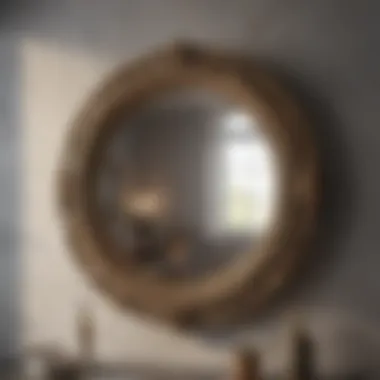
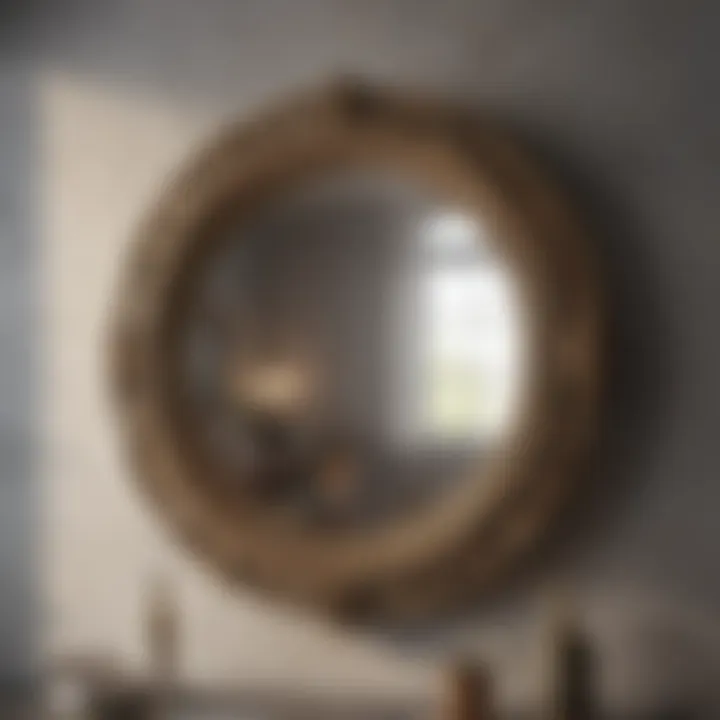
Intro
Mirrors are more than just a tool for checking if your hair is on point or if you've got toothpaste on your face. They can elevate the look of any space, especially the bathroom. When it comes to bathroom vanities, the right decorative mirror can become a statement piece, transforming an ordinary routine into a luxurious experience. In this guide, we'll explore the various aspects involved in choosing and arranging decorative mirrors for your bathroom vanity. From styles and sizes to practical tips on integrating them into your design scheme, this article aims to shine a light on how these reflective wonders can enhance your bath space.
Design Inspirations
Choosing the right design for your decorative mirrors can set the tone for your entire bathroom. With myriad options available, it helps to narrow down to current trends and harmonious color schemes.
Trending Styles
When it comes to trending styles for decorative mirrors, consider options that blend functionality with flair:
- Round Mirrors: These bring a soft, contemporary touch and work well in smaller spaces, making the area feel more open.
- Framed Mirrors: A bold frame can speak volumes. From rustic wood to sleek metal finishes, framed mirrors can accentuate your vanity beautifully.
- Backlit Mirrors: These modern designs not only serve practical purposes but also provide mood-enhancing lighting.
- Vintage Styles: Antique or vintage-inspired mirrors add character and charm, often creating a focal point in any bathroom.
Color Palettes
While the shape of the mirror plays a significant role, the color is equally important. The right hues can either complement or contrast the rest of your bathroom decor:
- Bold Colors: Bright colors offer a fun, playful vibe. Think of deep blues or rich greens for a striking effect.
- Neutral Tones: If you prefer a calm environment, go with soft whites, beiges, or grays. These colors create an illusion of space and serenity.
- Metallic Finishes: Gold or chrome frames can add a touch of glam, particularly if your bathroom features modern fixtures.
"Mirrors can often reflect not only your appearance but also your sense of style; choosing them wisely is essential for a cohesive look."
Product Recommendations
Once you have the design and colors sorted, the next step is selecting the right products. Here are some recommendations for enhancing your bath space with mirrors and accessories:
Bath Accessories
- Storage Solutions: Look for wall-mounted shelves or small tables to place decorative items along with your mirror.
- Lighting Fixtures: Consider adding sconces or pendant lights near the mirror. They can create a warm glow, making your bathroom feel inviting.
- Complements: Think decorative trays or small potted plants that can sit on the vanity beside the mirror to tie in the aesthetic.
Bedroom Essentials
If your bathroom is connected to a bedroom, consider continuity in design across both spaces. You might want to:
- Choose Similar Styles: Matching your bedroom mirror with the bathroom vanity can create a harmonious flow.
- Consider Sizing: Ensure the bedroom mirror is proportionate to the furniture it is placed beside, just like in the bathroom.
- Functional Touches: Mirrors can also serve a practical purpose in the bedroom, enhancing light and space.
In summary, selecting and integrating decorative mirrors into your bathroom vanity isn't just about aesthetics—it's about creating an experience. With careful thought and consideration of styles, colors, and complementary elements, you can elevate your bathroom to a new level of elegance and functionality.
Understanding the Role of Mirrors in Bathroom Design
In the realm of bathroom design, mirrors serve more than just a functional purpose; they are pivotal in shaping the atmosphere and character of the space. Their influence reaches deep into the aesthetics and utility, making them a focal point in any bathroom. From amplifying light to reflecting beauty, understanding their role becomes essential for homeowners and designers alike.
The Psychological Impact of Mirrors
Mirrors can greatly affect how we feel in a space. When you step into a bathroom with a well-placed mirror, it can create a sense of openness and tranquility. This is especially significant in smaller bathrooms, where space might feel quite cramped. By enabling light to bounce around, mirrors make these areas feel larger and airier. This simple trick of reflection can transform not only the space but also one's mood.
Moreover, the act of looking into a mirror—especially one that is designed beautifully—can evoke a sense of self-appreciation. It can encourage positive self-image, influencing daily routines such as grooming and self-care, where the focus shifts to the pretty aspects of oneself rather than flaws. Utilizing mirrors effectively can thus promote a more positive daily experience.
Functional Benefits of Bathroom Mirrors
Beyond their psychological influence, bathroom mirrors come packed with practical advantages that are vital for daily use.
- Lighting Enhancement: Many bathroom designs incorporate mirrors that can enhance the existing lighting. Strategically placed mirrors can reflect light from windows or fixtures, brightening up the space effectively.
- Space Optimization: In a tight spot, a well-placed mirror can visually expand the area, creating an illusion of more room. This is particularly valuable in powder rooms or compact en-suites where every square foot counts.
- Utility in Daily Routines: The functional aspect of mirrors can't be overlooked. They are essential for executing daily rituals—be it applying makeup, shaving, or just ensuring that the appearance is just right before stepping out. A good mirror allows for diverse angles and clear reflections.
"A bathroom without a mirror is like a kitchen without a stove. It serves a purpose but lacks the essence that makes the space come alive."
In summary, mirrors in bathrooms are not just decorative pieces; they hold the capacity to enhance psychological well-being while providing critical functionality. As we continue to navigate through the sections of this guide, it's clear that thoughtful selection and placement of mirrors are crucial for maximizing their potential in bathroom design.
Types of Decorative Mirrors
When selecting mirrors for a bathroom vanity, one must not overlook the variety that exists. Each type of decorative mirror can elevate the ambiance and utility of the space. From framed to LED mirrors, understanding this diversity helps create a cohesive design that reflects personal style and meets functional needs. Moreover, certain types of mirrors serve specific purposes, both in terms of practicality and aesthetic. Here, we dive into the various types of decorative mirrors and their significance in bathroom design.
Framed Mirrors
Material Choices for Frames
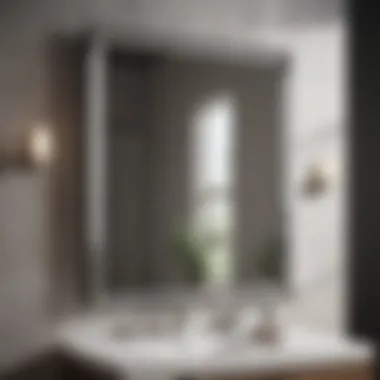
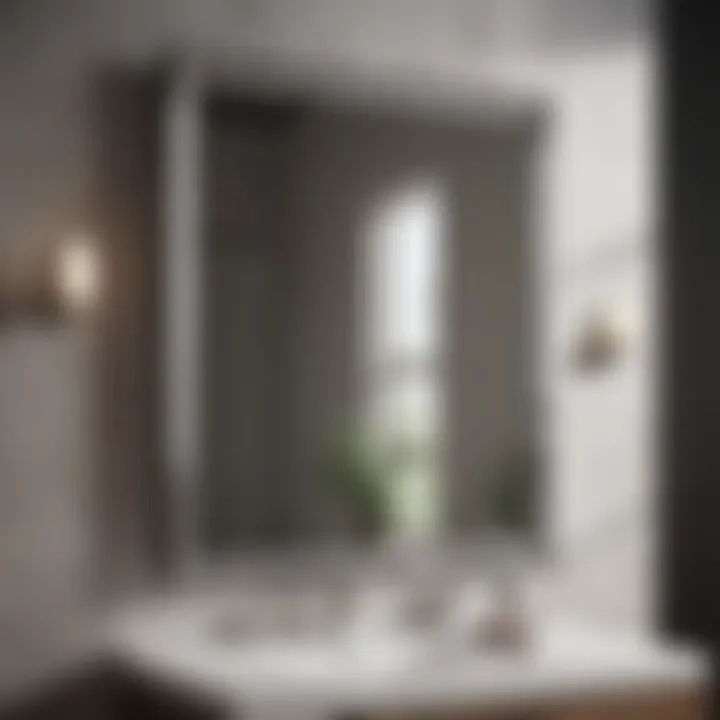
The materials used for mirror frames play a pivotal role in design. Wood, metal, and plastic are common choices, each boasting unique benefits. Wood provides warmth and can be carved into intricate designs, complementing rustic or traditional bathroom themes. On the other hand, metal frames are often sleek and modern, offering a contemporary edge to the space. A notable advantage of metal is its durability; it doesn't warp or corrode easily in humid environments. Plastic frames are lightweight and often available in a myriad of colors, making them a popular choice for those wanting to switch up decor on a whim. However, they may lack the robust appeal of wood or metal, though their affordability often tips the scales.
Styles of Framed Mirrors
The style of the framed mirror can transform the bathroom’s overall look. From ornate baroque frames that add drama to clean-lined minimalist designs, the options are endless. Ornate styles can bring a touch of luxury or vintage charm, while minimalist frames focus on simplicity and often enhance the illusion of space. Choosing the right style is essential not only for visual harmony but also for reflecting the homeowner's personality. Intricately designed frames might require more upkeep to keep dust out of the crevices, while smooth finishes can be easier to maintain but may not convey the same level of artistry.
Magnifying Mirrors
Purpose and Functionality
Magnifying mirrors serve a very specific purpose. They offer a closer view, which is particularly useful for daily grooming tasks like applying makeup or shaving. These mirrors maximize visual clarity and often come in varying magnification levels, with the typical choices being 5x or 10x. This particular focus adds functionality since it helps users catch every detail without strain. Still, the downside lies in the potential to distort reflections if the user is too close, leading to an exaggerated perception of imperfections.
Design Options
Designs for magnifying mirrors range from simple to extravagant. Whether wall-mounted or free-standing, the aesthetic style can match any decor theme. Some feature adjustable arms, enabling users to pull the mirror closer or push it away. This versatility is beneficial as it allows for comfortable positioning. However, one must consider that certain designs might take up more space, which could be a factor for smaller bathrooms.
Antique and Vintage Mirrors
Authenticity vs. Replicas
When discussing antique and vintage mirrors, the authenticity of the piece becomes vital. True antiques can add a sense of history and uniqueness to a bathroom. Their intricate designs often tell a story of bygone eras. Replicas, while often more affordable and easily accessible, lack that genuine touch but can deliver the same vintage flair without the hefty price tag. The challenge is choosing between the character of authenticity and the practicality of a replica, which is often lighter and easier to manage.
Finding the Right Fit
Finding an antique or vintage mirror that fits well can be a challenge but worthwhile. The mirror must blend with the existing vanity and overall bathroom design. An oversized antique mirror may overwhelm a small bathroom, while a dainty piece might gets lost in a grander setting. Therefore, taking measurements and visualizing the mirror's impact in the desired spot is crucial. The trade-off is clear: scrutiny in size and style matched with the rewards of character and distinctiveness unique to vintage finds.
Modern and Minimalist Mirrors
Key Characteristics
Modern and minimalist mirrors echo simplicity, often void of excessive ornamentation. Their clean lines and geometrical shapes align with a contemporary aesthetic, which can be refreshing in today’s often overly-decorated spaces. These mirrors prioritize functionality while making a subtle design statement, allowing them to blend seamlessly into a variety of bathroom styles.
Popular Designs
Frameless designs and those with thin edges are particularly popular in minimalist bathrooms. They create a sense of openness and can make small spaces feel larger. The downside is that they might lack the visual weight traditional framed mirrors provide, possibly making the room feel incomplete in some cases. However, their light, airy feel often works wonders in achieving a serene atmosphere, a key aspect of modern bathroom design.
Round Mirrors
Benefits of Round Mirrors
Round mirrors add a softness to the angular lines often found in bathrooms. They can create a calming effect and provide a beautiful contrast to square or rectangular vanities. Beyond aesthetics, round mirrors are often appreciated for how they disperse light; they can make a space feel more inviting and spacious. However, their round shape might not suit every style or vanity configuration, making it essential to choose wisely based on your bathroom layout.
Best Placement Practices
When it comes to placement, aim to hang a round mirror at eye level or slightly above, ensuring it serves its purpose without compromising style. Often, placing a round mirror above a sink creates a balanced visual flow. Consider pairing it with angular fixtures or accessories for an interesting dynamic. The challenge is ensuring that the round mirror doesn't clash with other shapes in the bathroom space, which may disrupt visual cohesion.
LED Mirrors
Lighting Options
LED mirrors offer functional lighting in addition to their reflective capabilities. With built-in lighting options, they illuminate the face evenly, making them a favorite for grooming tasks. The key characteristic here is versatility; many of these mirrors allow users to adjust brightness levels, catering to different needs. Nevertheless, the wiring and installation can be more complex than traditional mirrors, requiring additional consideration.
Energy Efficiency
One notable advantage of LED mirrors lies in their energy efficiency. Unlike incandescent options, LED lights consume less power and have an extended lifespan, making them a more sustainable choice over time. However, the initial investment may be higher, which can deter some homeowners. Yet, considering the long-term savings on energy bills, investing in an LED mirror can be a smart decision for eco-conscious renovators.
Choosing the Right Size and Shape
Choosing the right size and shape for bathroom mirrors is crucial, not just for aesthetic appeal but also for functionality. A mirror's size should complement the vanity and the overall room layout, while its shape can influence both the style and perception of space. Selecting mirrors that fit well helps in elevating the bathroom’s design while ensuring that the area feels cohesive and thoughtfully arranged.
Assessing Bathroom Space
Before diving into styles or materials, assessing the available bathroom space is essential. This begins with measuring the specific dimensions of the wall where the mirror will hang. It’s like trying on clothes; you need to know your size to choose what fits.
Consider the following:
- Wall Space: Ensure there is enough wall to hold the mirror without overwhelming the area.
- Vanity Size: The mirror should relate proportionally to the vanity; usually, a mirror that is slightly narrower than the countertop creates a balanced look.
- Overall Layout: Observe how the mirror will interact with doors, windows, and other fixtures. Lack of planning can lead to awkward placements.


Once measurements are taken, an idea can start to form on what size mirror will make a statement without crowding the room.
Proportional Design Considerations
When delving into design, proportion is a game changer. An enormous mirror in a petite bathroom can create a sense of imbalance, while a tiny mirror in a spacious area can feel lost, almost like a fish out of water.
Keep in mind:
- Ratio: The mirror should occupy roughly two-thirds to three-quarters of the width of the vanity. This ratio will guide you to a mirror size that feels right.
- Height: If your bathroom has high ceilings, you can afford a taller mirror to draw the eyes up, enhancing the sense of space. Conversely, in lower-ceiling bathrooms, opt for shorter mirrors to avoid a cramped feeling.
- Shape Matters: Rectangular mirrors suit modern spaces, while circular ones can soften and invite friendliness into the decor.
Being mindful of these proportions not only ensures aesthetic appeal but also enhances functionality, allowing for adequate reflection.
Layering with Other Elements
A mirror doesn’t live in isolation, and its relationship with other elements in the bathroom is vital. Layering can refer to the interaction of the mirror with surrounding visuals – colors, textures, and accessories all matter. Achieving balance requires consideration of what else will be included in the space.
Here are some pointers:
- Textures and Colors: If the vanity is made of dark wood, a light-framed mirror can offer contrast that’s visually pleasing. Mixing materials can create depth.
- Art and Decor: Positioning a decorative mirror surrounded by artwork or other decorative pieces can create a gallery effect, turning the bathroom into a personal gallery.
- Light Sources: Mirrors enhance natural light. Placing them near windows or light fixtures can amplify the brightness in the room, making it look larger and more inviting.
Consider this snippet of wisdom: "Mirrors don’t only reflect what’s in front of them; they can enhance what’s around them too!"
Taking the time to layer mirrors with other elements not only maximizes their functionality but enriches the room’s visual narrative, making your bathroom feel intentional and curated.
Placement Strategies for Optimal Effect
When it comes to decorating your bathroom, the way you place your mirrors can truly make or break the space. Proper placement is not just about aesthetics; it also affects the functionality and the overall feel of the bathroom. Mirrors can enhance light, create depth, and serve practical purposes, making their placement a crucial consideration in your design strategy. Below, we explore the key aspects of achieving optimal effect through strategic mirror placement.
Height and Alignment
Getting the height of your mirror right is essential for both usability and style. Ideally, the center of the mirror should align with the average eye level for the primary users of the bathroom. Generally, this falls between 5 feet 6 inches and 6 feet from the floor. For homeowners who share a bathroom, like couple or families, installing the mirror slightly higher can work in favor of all users.
- Consider the vanity height: If your bathroom vanity is lower than average, adjust the mirror height to maintain balance.
- Alignment with other fixtures is also something worth pondering. For seamless flow, align your mirror's edges with the faucet or the edges of your vanity.
Creating Visual Interest
Mirrors can be a focal point that draws the eye immediately upon entering the bathroom. This is where creativity comes into play. Instead of settling for a standard rectangle, think about unconventional shapes or decorative frames that complement your decor or even clash expertly with it to create a statement.
"A mirror is more than just a reflection—it defines a space."
Some tips to enhance visual interest include:
- Layering: Pair a large mirror with smaller accent mirrors. This creates a gallery-like effect that’s visually appealing.
- Textures and Colors: Use mirrors with different textures or frames, such as wood or metal. A rustic wood frame can warm a modern bathroom, while a sleek, metallic one can enhance a minimalist design.
Mirror Arrangement Techniques
Arranging mirrors in a bathroom can be an art in itself, elevating both functionality and style. Successful arrangements depend on the layout of your space and the existing vanity design. Here are some strategies to consider:
- Symmetry: Placing two identical mirrors on either side of a vanity creates a sense of harmony. It complements balanced designs and gives an upscale touch.
- Asymmetry: Alternatively, an off-center mirror arrangement can create a more relaxed and casual atmosphere. For instance, using an oversized mirror above the sink, paired with smaller ones at either side gives an intriguing layered effect.
- Functional zones: If your bathroom has multiple areas (for instance, a sink vanity and a makeup station), consider dedicated mirrors for each space.
In summary, effective placement of mirrors can enhance not just the look of your bathroom, but also its functionality. When you’re making your decisions on height, alignment, visual interest, and arrangement, it’s all about harmonizing beauty with everyday usability.
Enhancing Ambiance through Lighting
Lighting plays a crucial role in transforming a bathroom into a serene haven. When discussing decorative mirrors, it’s vital to not only focus on their visual appeal but also how they interact with light. The right lighting can elevate the ambiance, making the space feel larger and more inviting. It enhances the functionality of your mirrors, ensuring you have the best light for grooming or simply appreciating your reflection.
Types of Bathroom Lighting
Different types of lighting have unique qualities that can significantly impact the atmosphere of your bathroom. Here are the primary types:
- Ambient Lighting: This serves as the main source of light, offering overall illumination to the bathroom. Ceiling-mounted fixtures or recessed lights often provide such lighting.
- Task Lighting: This is important for activities such as shaving or applying makeup. Task lighting is often placed near mirrors or other functional areas. Wall sconces or pendant lights can work wonders here.
- Accent Lighting: Used to highlight specific features of the bathroom, such as artwork or decorative elements, accent lighting creates depth and visual interest. Consider LED strip lights or small spotlights for this.
The interplay of these lighting types not only emphasizes your decorative mirrors but also contributes to the overall design integrity of the space.
Layering Light Sources
Layering light sources is an effective strategy to develop a multi-dimensional environment. By combining ambient, task, and accent lighting, you can manipulate the light in ways that suit different times of day and moods. For instance:

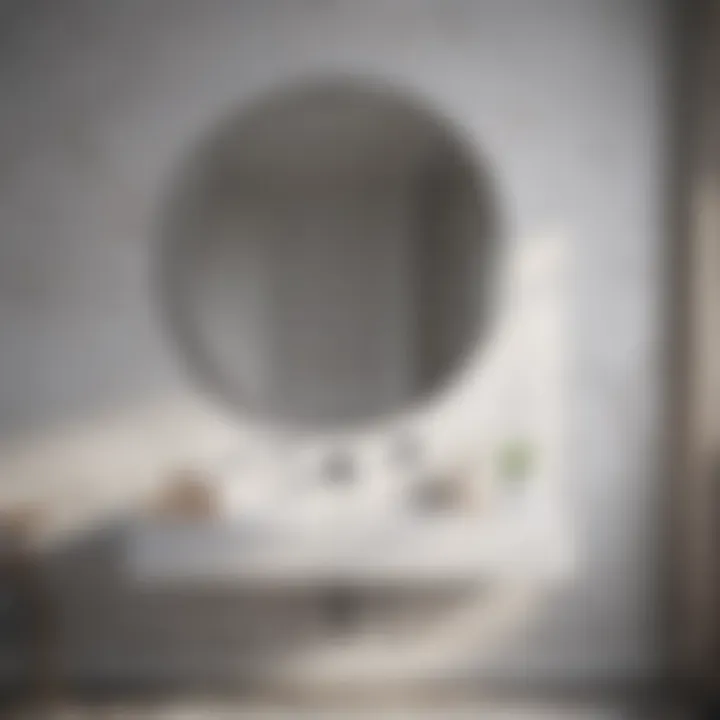
- Start by establishing strong ambient light that covers all corners of the bathroom.
- Add task lighting around the mirror to focus on functionality. This dual approach ensures you can see clearly without harsh shadows.
- Finally, sprinkle in accent lighting to create a cozy atmosphere during relaxation times.
This method gives you the flexibility to customize the brightness and essence of the space according to your needs.
Complementing Mirrors with Ambient Lighting
When it comes to decorative mirrors, ambient lighting shouldn’t be an afterthought. A well-placed mirror can reflect light beautifully, helping to spread illumination throughout the room. Here’s how to get it right:
- Positioning: Place your mirrors in locations where they can capture the most natural light during the day.
- Light Fixtures: Opt for soft, diffused light sources that evoke warmth rather than harsh brightness. Flush mounts or globe fixtures can create flattering shadows.
- Color Temperature: Consider using light bulbs with a warmer color temperature, typically around 2700K to 3000K, to create a cozy and welcoming atmosphere.
When executed well, the arrangement of light around mirrors not only enhances their aesthetic but turns them into practical, functional pieces in your bathroom design.
"The right light has the power to change everything—your mood, the room, and the effectiveness of your beloved decor."
Maintenance and Care for Bathroom Mirrors
Taking care of your bathroom mirrors is essential for preserving their beauty and functionality. As the reflection of your personal style, mirrors can significantly affect your bathroom's overall aesthetic. Thus, regular maintenance not only keeps them looking their best but also extends their lifespan, ensuring you enjoy their benefits for years to come. In this section, we will cover both cleaning techniques to keep your mirrors spotless and methods for preventing damage, ensuring a flawless experience each time you step into your bathroom.
Cleaning Techniques
To maintain the clarity and shine of your bathroom mirrors, effective cleaning is crucial. Here are some helpful techniques:
- Use a microfiber cloth: This type of cloth is gentle and effective in removing dust and smudges without scratching the surface. Avoid paper towels, since they can leave lint behind.
- Homemade cleaner: Mix equal parts of vinegar and water in a spray bottle. This natural solution is powerful enough to cut through grime and leaves no streaks. Just spray and wipe!
- Avoid harsh chemicals: Stay away from ammonia-based cleaners, as they may discolor or damage the protective coating on your mirrors over time.
Tips:
When cleaning, take care to wipe in a circular motion. This helps to evenly distribute your cleaning solution and ensures every spot gets the attention it needs.
"Regularly cleaning your mirrors can make all the difference in how you experience your space."
Preventing Damage
Proper care goes beyond just cleaning. To keep your bathroom mirrors from sustaining damage, consider these preventive measures:
- Strategic placement: When hanging mirrors, ensure they're not near sources of steam or water—like showers or sinks—to reduce condensation buildup.
- Coat with glass protection: Applying a glass treatment can help create a barrier against moisture and grime, making future cleaning tasks much easier.
- Handle with care during cleaning: When cleaning, be sure not to apply too much pressure or use abrasive materials that could scratch the glass surface.
Keep in mind: Regular inspection for any chipped edges or loose frames can prevent larger issues down the line, saving you from having to replace mirrors prematurely.
By taking these steps in maintenance and care for your bathroom mirrors, you ensure they continue to enhance your space while providing you a practical solution for daily grooming. A little attention truly goes a long way!
Trends in Decorative Mirrors
In the evolving realm of interior design, decorative mirrors for bathroom vanities are more than mere functional items; they are pivotal elements that encapsulate personal style. The trends surrounding these mirrors offer a fascinating glimpse into how materials, shapes, and design philosophies shape not just the aesthetic but also the atmosphere of bathroom spaces. Understanding these trends holds significant benefits for homeowners seeking to create an inviting and visually striking bathroom.
Sustainable Materials
In recent years, there has been a marked shift towards eco-conscious living, and the bathroom is no exception. When selecting decorative mirrors, choosing sustainable materials is not just a trend; it’s a commitment to creating a greener home. Materials such as reclaimed wood or bamboo are gaining traction due to their minimal environmental impact. Many manufacturers are embracing recycled metals for frames or using glass that’s been responsibly sourced.
By integrating sustainable materials, individuals not only reduce their carbon footprint but also add a unique story to their decor. The textures and natural finishes genuinely resonate with contemporary design sensibilities, harmonizing well with various bathroom themes from rustic retreats to sleek modern spaces.
New Aesthetic Approaches
As design paradigms shift, the aesthetics of mirrors have also evolved. One notable trend is the rise of asymmetrical and abstract designs, which challenge the conventional wisdom of symmetry in decor. These asymmetric mirrors can serve as captivating focal points, often acting as works of art rather than merely functional pieces.
Unique frames in different colors and textures—think matte black, antique gold, or even vibrant pastels—bring life to otherwise standard bathroom elements. Incorporating geometric shapes or mirrors with intricate embellishments can enhance the overall design while infusing a personal touch.
Furthermore, the use of color accents in mirror frames is a movement that shouldn’t be overlooked. A vibrant frame not only draws the eye but also sets the mood in the space, allowing homeowners to express personality and style.
"Mirrors serve dual functions: they reflect our image and enhance the look of our spaces. Choosing contemporary designs can turn an everyday mirror into a statement piece."
By staying attuned to these trends, homeowners—especially those looking to refresh their bathrooms—can make informed choices that elevate simplicity to sophistication. The key lies in embracing innovative materials and aesthetic changes; these aspects can significantly impact the utility and ambiance of a bathroom, ultimately creating a space that feels both personal and polished.
Culmination
In summary, the inclusion of decorative mirrors in bathroom designs stretches beyond mere aesthetic appeal. They bring forth a multitude of benefits that are essential for enhancing the overall functionality of the space. With careful consideration towards styles, materials, and placement, mirrors serve not only practical purposes, such as reflecting light and providing a clear view for grooming, but they also establish a captivating ambiance that can transform the bathroom into a serene retreat.
Summary of Key Points
- Role: Mirrors are integral to bathroom design, reflecting light and adding depth to a potentially small or dim space.
- Variety of Styles: From framed to LED-enhanced options, the range of decorative mirrors provides countless opportunities for personal expression and style.
- Size and Shape Considerations: Choosing the right size and shape is crucial. Oversized mirrors can create an illusion of more space, while smaller mirrors can complement intricate decor elements.
- Placement Strategy: The height and alignment of mirrors significantly impact their effectiveness and the overall harmony of the room.
- Lighting Pairing: Combining mirrors with the proper lighting accentuates their functionality and aesthetic value, enhancing the user experience.
Final Thoughts on Selection and Design
Selecting the right decorative mirror goes beyond picking what looks good. It’s about harmonizing functionality with style, ensuring that every choice made contributes positively to the bathroom environment. Consider the space available and the overall design theme of the room. A vintage mirror might be striking in a rustic-style bathroom, while a sleek, modern design may better suit a contemporary setting.
Ultimately, this decision affects not just how the bathroom looks, but how it feels to those who use it. A well-placed and thoughtfully chosen mirror can make daily routines more enjoyable while also turning a mundane space into a stylish one.
"Mirrors reflect not just our image, but also the energy we create in the spaces we inhabit."
Therefore, embrace the art of selecting and placing decorative mirrors; they're not just functional pieces but key elements that contribute to the ambiance and charm of any bathroom.



